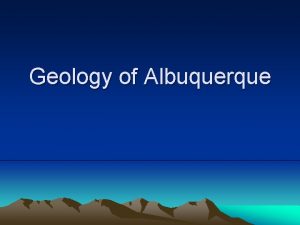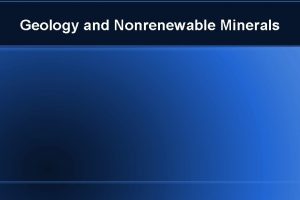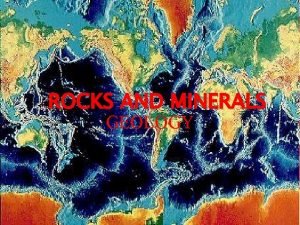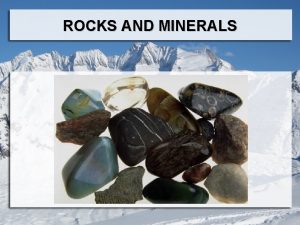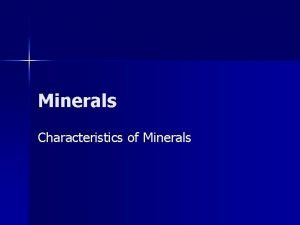Minerals Geology Slides 11 21 Minerals For an












- Slides: 12

Minerals Geology: Slides 11 -21

Minerals • For an object to be considered a mineral it must meet the following criteria: – It must be naturally occurring – It must be a solid – It must have a definite chemical composition – It must have a definite crystal structure – It must be inorganic (contains nothing that was ever living)

• 1. ) Silicates Mineral Types – 90% of all minerals belong to this group – Silicon + a metal (Al, Fe, etc. ) – Atoms for a silica tetrahedron – The silica tetrahedron causes the minerals to have their distinct crystal shapes. – Feldspars – most common type of silicate found in the Earth’s crust (Al has replaced some of the Si in the tetrahedron)

Mineral Types • 2. ) Carbonates – CO 3 bonded to a metal (common around here) – Generally react to acids (creating rocks that are easily dissolved by acid rain making caves and sink holes)

Mineral Types • 3. ) Iron Oxides and Iron Sulfides – Iron combined with oxygen and sulfur – Very heavy, dense minerals – Resemble a piece of metal

Identifying Minerals • Minerals are identified using the following properties: (Some properties will be useful for some minerals and useless for others. )

Identifying Minerals • 1. ) Color – least useful identification property • 2. ) Luster – The way a mineral reflects light (vitreous [glassy], pearly, metallic, non-metallic [earthy]) • 3. ) Crystal Shape – atoms forming distinct crystal patterns

Identifying Minerals • 4. ) Hardness – The resistance of a mineral to being scratched – Uses the Mohs Hardness Scale – Mohs Scale ranks minerals from 1 – 10 (1 is softest and 10 is the hardest) – Talc = 1 and Diamond = 10 (not always whole numbers)

Identifying Minerals • 5. ) Streak – The color of a mineral’s powder – To obtain the mineral’s powder you rub the mineral across a Streak Plate (porcelain) – Mineral color and the mineral streak are not necessarily the same. (All minerals do not have a streak – some are too hard)

Identifying Minerals • 6. ) Cleavage and Fracture – The way in which a mineral breaks or splits – Cleavage = smooth break on a flat surface – Fracture = rough break with jagged edges

Identifying Minerals • 7. ) Specific Gravity – Ratio of the mass of a mineral compared to the mass of an equal volume of water

Identifying Minerals • 8. ) Special Properties – Taste – Odor – Sound – Radioactivity – Fluorescence – Double refraction – Reacts with acid – Magnetic
 Robert pushes the box to the left
Robert pushes the box to the left A small child slides down the four frictionless slides
A small child slides down the four frictionless slides Vilken grundregel finns det för tronföljden i sverige?
Vilken grundregel finns det för tronföljden i sverige? Jätte råtta
Jätte råtta Förklara densitet för barn
Förklara densitet för barn Ministerstyre för och nackdelar
Ministerstyre för och nackdelar Tillitsbaserad ledning
Tillitsbaserad ledning Plats för toran ark
Plats för toran ark Nationell inriktning för artificiell intelligens
Nationell inriktning för artificiell intelligens Nyckelkompetenser för livslångt lärande
Nyckelkompetenser för livslångt lärande Sju för caesar
Sju för caesar Ledningssystem för verksamhetsinformation
Ledningssystem för verksamhetsinformation Mästar lärling modellen
Mästar lärling modellen


















